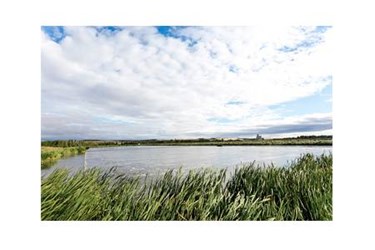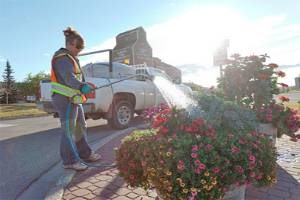Dawson Creek, Shell Strike Innovative Water Partnership

Dawson Creek water reclamation centre reduces water Shell uses for fracking gas wells
An innovative partnership between Dawson Creek, BC and Shell Canada solved the community’s sewage and water problems, while reducing the amount of fresh water used in hydraulic fracturing.
Dawson Creek – a small city in the heart of B.C.’s northeastern natural gas producing region – was suffering through a devastating drought that was straining the community’s water supply.
The depleted rivers and water shortage was not only cause for concern for residents, but new gas drilling projects in the area were at risk of shutting down as the city limited water use. It was a difficult situation. Nobody wanted to see the much-needed economic benefits driven out of the area, but the water just wasn’t there.
And as an extra burden on scarce water supplies, all the city’s sewage was being sent to lagoons that would eventually seep into the creek.
City council began searching for solutions. New, innovative water treatment technology that would see the city’s sewage transformed into water clean enough to spray around the city and even used by industry out in the field seemed like an idea too good to be true.
“Water’s a huge issue for us as a community especially when you start to feel the demands for it not only from the community but for industrial activity taking place in our community,” says current Dawson Creek Mayor Dale Bumstead.
“The city was built on a creek as the name [suggests], we didn’t have a large lake or a major river running at our doorstep to provide us with a huge flow of water. We have a water shed that we pull water into.”
 A new water reclamation centre for Dawson Creek would solve all of their problems, but the cost of a project like that would be too rich for a city with Dawson Creek’s budget.
A new water reclamation centre for Dawson Creek would solve all of their problems, but the cost of a project like that would be too rich for a city with Dawson Creek’s budget.
That’s when Shell Canada came on board. The company had been producing natural gas in the area for years and was already committed to the area. The community needed help with their water issues, and Shell Canada saw the opportunity to do some good for everybody’s benefit.
A partnership was struck which saw the water treatment plant constructed with Shell’s financial backing. The city would increase their water for municipal uses and Shell would be able to virtually eliminate fresh water use for their hydraulic fracturing operations in the area.
“One of our business drivers is having those innovative partnerships between industry and the community,” says Shell Canada spokesman Stephen Doolan. “Because we’re going to be in the area for a long time, we’re always looking at ways to help conserve water in the local area. For us, it was with that principle in mind. We’re going to be there for a long time so let’s make sure we’re operating in a proper fashion.”
About Dawson Creek
The Dawson Creek Reclaimed Water Plant is the final step in the process to treat the City’s municipal waste water for reuse by the community and the oil and gas industry in the area. Shell uses a portion of this reclaimed water to supplement any shortfalls in recycled water at Groundbirch, greatly reducing the need for fresh water in hydraulic fracturing operations.
The Dawson Creek water reclamation plant was opened in September 2012, with a capacity of 4,000 cubic metres a day. Shell agreed to help pay for it and also built a 48 kilometre pipeline that would divert their share of the reclaimed water to their Groundbirch gas field operations west of the city.
The amount of fresh water the company has conserved has been substantial.
“It’s been an amazing opportunity for us in terms of a community that now has the opportunity to provide upwards of 4,000 cubes of water per day to industry that is reclaimed water that would normally go through our settling ponds and sewage lagoon ponds.
Eventually over time would run into creek and leak out.
“So now for us to reuse and reclaim that sewage water, put it into a system and process that allows it to be a valuable commodity to industry that they can utilize. It’s just been an absolute win-win for us as a community and industry in our area.
And the deal also addressed the wear and tear on municipal roads and the noise from water tankers transporting water along the highways.
“With the Dawson Creek arrangement, we’re pulling those tankers off the road plus we’re giving the benefit to the folks of Dawson Creek that they can use the excess water that Shell doesn’t use,” Doolan says. “In this case, the Dawson Creek facility was certainly a solution around water usage.”
As the development of natural gas, the cleanest-burning fossil fuel, continues to play a key role in Canada’s energy future, ideas and collaborations like the Dawson Creek water plant are being seen by industry and Canadians as a step in the right direction. Because hydraulic fracturing of natural gas wells requires large volumes of water, finding solutions for preserving Canada’s water resources is crucial.
Industry is continually looking at new technology to help reduce the impact of energy development on the environment and limiting fresh water use wherever they can.
“It’s been a significant issue,” Bumstead says. “And this water reclamation plant and partnership with Shell has just been an example of the community and industry working together to solve a common issue.”
The whole project is a model that could be replicated in other areas, as part of Shell’s Preserving Fresh Water through Innovation initiative.
“We’re using it as a best case/test case,” Doolan says. “No matter which area we’re operating in, whether it’s northeast B.C. or somewhere in Alberta, one of the principles we operate by is that we want to reduce the amount of water. We’re looking at ways to do that through technology and innovation.”
Source: Beacon News
